Collector’s legacy lives in Hummel exhibit
Published 11:28 am Tuesday, October 4, 2022

- Hummel figurines were created by Berta Hummel, who was born in Bavaria, Germany, in 1909.
VALDOSTA — Georgianna Baer Manning’s Hummel figurine collection began in 1968 with a gift from her husband, Stephen Joseph Manning. She was 26 years old, and she adored the timeless, heartwarming scenes of innocence and playfulness, of rosy-cheeked children in a variety of settings, performing everyday activities.
At the time of her death on March 3, 2021, she had accumulated 81 Hummel figurines. Most of them were purchased to commemorate special occasions, like births and holidays. Others she acquired through membership in the M.I. Hummel Club.
Stephen Manning, an exterminator with Valdosta State University’s Office of Environmental and Occupational Safety, said his wife’s favorite Hummel figurine was Playmates, the porcelain recreation of a young farm boy playing with his pet rabbits, two in a brown basket and one on his lap. He recently donated her Hummel collection, including a few Hummel-related books and magazines, to Odum Library.
“I looked at the collection cramped on shelves and thought this was a good way to honor her,” said the long-term VSU staff member. “My wife was a giving person, and I know she would so enjoy knowing that her beloved Hummel figurines will continue to spread cheer for many generations to come.”
The Georgianna Baer Manning Hummel Exhibit at Odum Library will remain open through Nov. 20. It is located on the first floor of the library in the North Lobby display cases.
Hummel figurines are the creation of Berta Hummel who was born in Bavaria, Germany, in 1909. She was a happy and creative child who loved the outdoors.
Wanting to encourage her artistic talent, her family enrolled her in a boarding school of the Sisters of Loreto in Simbach am Inn at the age of 12. Six years later she entered the Academy of Applied Arts in Munich, a prestigious school for the arts.
After graduation, Hummel joined the Franciscan Sisters of Siessen in Bad Saulgau. She had previously met some of the women from the congregation while studying at the Academy of Applied Arts. She took the name Sister Maria Innocentia and began teaching art in a school run by the convent. In her free time she created paintings of rosy-cheeked children at play. Her work soon gained the attention of a publisher who printed her paintings as postcards and Franz Goebel, the owner of a porcelain company who turned her paintings into three-dimensional figurines.
By 1937 Hummel’s art had gained the unwanted attention of Adolf Hitler, who denounced her work, claiming it depicted German children as having “hydrocephalic heads.” Nazi authorities banned the distribution of her work in Germany. A Nazi magazine noted that her work depicted German children as “brainless sissies.”
With the start of World War II, the Nazis closed all religious schools in Germany, including Hummel’s convent. Many of the sisters were tossed out into the streets. The few that remained were confined to a small area in their facility. Hummel lived in what has been described as a small cell, where she slept and continued to create her art. She succumbed to tuberculosis in 1944 and died two years later.
After her death, Goebel and Hummel’s Franciscan sisters continued to produce the porcelain figurines through October 2008.
The Georgianna Baer Manning Hummel Exhibit at Odum Library may be explored virtually at https://archivesspace.valdosta.edu/repositories/2/resources/494.
Visit https://www.valdosta.edu/academics/library/ for Odum Library hours.


